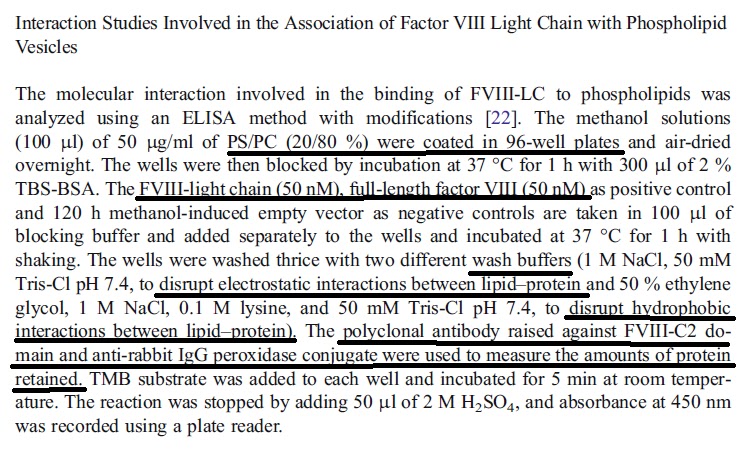Here is a 2013 paper on FVIII LC purification from Pichia pastoris....
The authors claim that ethylene glycol is able to disrupt the hydrophobic interactions between the lipid and the protein and hence decrease the ELISA signal.
Now take a look at some papers reporting that antibodies binding to the C-2 region prevent FVIII-PS interaction. here's a 1989 paper (just the abstract) and then the 2001 paper. Hydrophobic residues in C-2 play a role in interrupting this interaction between FVIII C-2 (LC) and the phospholipid because this is where the antibody is supposed to bind. Yet, the authors of the 2013 paper above manage to use an ELISA using an antibody against C-2 AND get the LC to bind both the antibody AND the PL. But they claim that hydrophobic interactions play a role in the lipid-FVIII interaction. There is no discussion on the possibility of a shared epitiope on C-2 that would bind to both lipid and antibody and no evidence that this particular polyclonal antibody does not fall under this category.

Sudheer Reddy AR, Padikara Kutty Satheeshkumar, & Mookambeswaran A. Vijayalakshmi (2013). Expression, purification, and partial in vitro characterization of biologically active human coagulation Factor VIII chain (A3-C1-C2) in Pichia pastoris Applied Biochemistry and Biotechnology DOI: 10.1007/s12010-013-0338-4
In the two figures below, how do we know that this is really FVIII LC and what the antibody has detected really is the LC? No positive control for Western or SDS PAGE?
IN ELISA procedure described below, note that the well surface is coated with PS or PC, then FVIII-LC is added and then the antibody.
So these authors have no problem using PL/PS and the antibody against C-2 region in that order....
The authors claim that ethylene glycol is able to disrupt the hydrophobic interactions between the lipid and the protein and hence decrease the ELISA signal.
Now take a look at some papers reporting that antibodies binding to the C-2 region prevent FVIII-PS interaction. here's a 1989 paper (just the abstract) and then the 2001 paper. Hydrophobic residues in C-2 play a role in interrupting this interaction between FVIII C-2 (LC) and the phospholipid because this is where the antibody is supposed to bind. Yet, the authors of the 2013 paper above manage to use an ELISA using an antibody against C-2 AND get the LC to bind both the antibody AND the PL. But they claim that hydrophobic interactions play a role in the lipid-FVIII interaction. There is no discussion on the possibility of a shared epitiope on C-2 that would bind to both lipid and antibody and no evidence that this particular polyclonal antibody does not fall under this category.

Why do reviewers not ask for positive controls and why do they not compare what is done in a manuscript to what is in the field?













No comments:
Post a Comment